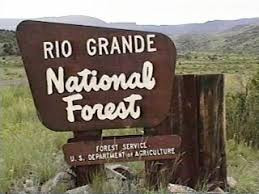Rio Grande National Forest gives update on aerial survey

RIO GRANDE NATIONAL FOREST — Rio Grande County Commissioners met with Rio Grande National Forest Forestry Supervisor Adam Moore who gave a brief presentation about the health of the forest and results from the 2021 aerial survey. According to Moore, the survey was not complete and that only a portion of the forest was surveyed due to restrictions from the COVID-19 pandemic.
“I will give you a quick summary of the forest health report that our agency does with the US Forest Service. We did not fly the entire state and the entire county like we typically do because of restrictions last year, so we pretty much focused on the southwest corner from Jasper over to Summitville. Everything else that we talk about in the report is something we have seen on the ground and not through an aerial view.”
Moore continued to state that the forest health is looking average for the year and that beetle activity has slowed some due to the lack of food sources available.
“The big emphasis of this year’s report was wildfire since last year we had one of the three largest wildfires in Colorado’s history and 10 of the largest wildfires in Colorado’s history have all occurred since 2002. Because of that, there are a lot of projects in here, things that have been done to help communities and how they have survived wildfires better last year than in previous years,” Moore said.
Moore spoke about projects closer to home that the agency completed.
“One of the projects that we did closer to home to help communities survive was up at Colorado State University’s campus where we worked with housing services to do some forest health management, so we did some thinning, reduced Conifer from Aspen areas,” Moore said.
In the report submitted to the board, it continued to state, “The Cameron Peak Fire roared through Colorado State University’s Mountain Campus area in Pingree Park on Oct. 9-10, 2020. As flames torched the surrounding forests of lodgepole pine and mixed conifer, fire crews successfully saved all structures on campus, thanks to ongoing mitigation work. A decade ago, CSU Housing and Dining Services and the Colorado State Forest Service embarked on a series of projects on the campus to protect structures and thin stands of beetle-killed trees in the wake of the mountain pine beetle epidemic. Staff with the CSU Mountain Campus and CSFS Fort Collins Field Office cleared thousands of trees growing adjacent to power lines, log cabins and other structures in critical areas around campus. Crews also felled and removed many hazardous trees. At the time, the goal was to improve forest health and clear beetle-killed trees.”
Moore continued stating that Colorado was a negative state for carbon emissions from forests that have been through wildfires or have dead trees due to insect activity.
“Some of the other things in the report include discussions on carbon and climate due to some of the things that Gov. Jared Polis wanted to look at whether or not the state could become a carbon-neutral state and the unfortunate aspect of that was that Colorado is actually a net-negative state in terms of forests holding carbon and part of that is when we lose acres due to fire or insect disease, is that yes, the carbon is still there in the tree but it's not bringing in carbon anymore,” Moore said.
As far as the southwest corner that was surveyed this year, there was limited change.
“You can see some spots with spruce beetles, but as I’ve mentioned for the last four, five years, the spruce beetle is still the number one agent killing trees in Colorado, but the acreage keeps going down in the San Luis Valley. We just don’t have the food source anymore,” Moore said.
Commissioners thanked Moore for the information before moving on to the next topic on the agenda. The entire report can be viewed at https://csfs.colostate.eduand look for the 2020 Report on the Health of Colorado’s Forests (7 MB PDF) New 2021 under the Publications tab at the top of the page.



